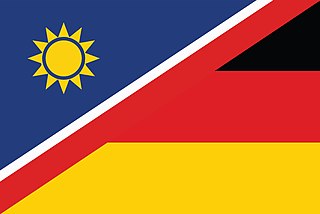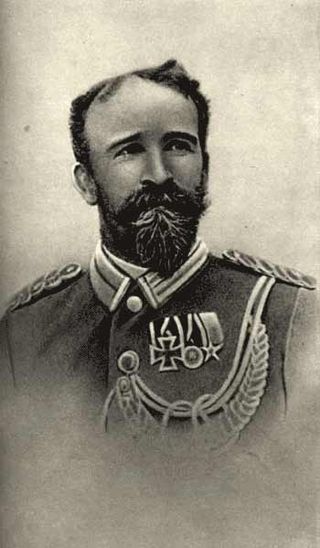
Windhoek is the capital and largest city of Namibia. It is located in central Namibia in the Khomas Highland plateau area, at around 1,700 m (5,600 ft) above sea level, almost exactly at the country's geographical centre. The population of Windhoek, which was 486,169 in 2023, is constantly growing due to a continued migration from other regions in Namibia.

German Namibians are a community of people descended from ethnic German colonists who settled in present-day Namibia. In 1883, the German trader Adolf Lüderitz bought what would become the southern coast of Namibia from Josef Frederiks II, a chief of the local Oorlam people, and founded the city of Lüderitz. The German government, eager to gain overseas possessions, annexed the territory soon after, proclaiming it German South West Africa. Small numbers of Germans subsequently immigrated there, many coming as soldiers, traders, diamond miners, or colonial officials. In 1915, during the course of World War I, Germany lost its colonial possessions, including South West Africa ; after the war, the former German colony was administered as a South African mandate. The German settlers were allowed to remain and, until independence in 1990, German remained an official language of the territory alongside Afrikaans and English.

Curt Karl Bruno von François was a German geographer, cartographer, Schutztruppe officer and commissioner of the imperial colonial army of the German Empire, particularly in German South West Africa where he was responsible on behalf of Kaiser for the foundation of the city of Windhoek on 18 October 1890 and the harbor of Swakopmund on 4 August 1892.

Duwisib Castle, sometimes spelt Duwiseb or Duweseb, is a grand pseudo-medieval looking fortress in the hills of the semi-arid Southern Namib region of Namibia, 72 km southwest of Maltahöhe, Hardap Region. It was built in 1909 to serve as the residence of Hans Heinrich von Wolf, a German military officer. Since 1979 the castle has been owned by the government.
Articles related to Namibia include:

Swakopmund railway station is a railway station serving the town of Swakopmund in Namibia. It is part of the TransNamib railway network. Its IATA code is ZSZ.

Hochland Park is a residential suburb in Windhoek, the capital of Namibia. It is named after the German Khomas Hochland, the central-Namibian plateau area in which Windhoek is situated.

Sanderburg is the smallest of three castles in Windhoek, Namibia. It was built between 1917 and 1919 by architect Wilhelm Sander who designed it as his own place of residence. Its architectural style combines several medieval features.

Heinitzburg is one of the three castles in Windhoek, Namibia. It was built in 1914 by architect Wilhelm Sander.

Wilhelm Sander was a master architect and contractor working for Sander & Kock known for his work in German South West Africa, today's Namibia.

German South West Africa was a colony of the German Empire from 1884 until 1915, though Germany did not officially recognise its loss of this territory until the 1919 Treaty of Versailles.

The Windhoek Industrial and Agricultural Show is an annual trade fair in Windhoek, the capital of Namibia. It combines an agricultural exhibition, several industrial and retail offerings, and a range of entertainment facilities. The Windhoek Show was first held in 1899 and is since 1966 conducted annually. Held during the first week of October, the Windhoek Show is the biggest industrial and agricultural exhibition in Namibia. It attracts close to 100,000 visitors per year.

The Alte Feste is a fortress and museum in downtown Windhoek, the capital of Namibia. It is situated in Robert Mugabe Avenue, next to the Independence Memorial Museum.
GDR-Children of Namibia is a colloquial term denoting black Namibian children that were raised in East Germany, also known as the German Democratic Republic (GDR). During the South African Border War, the children of hundreds of Namibian refugees and political exiles were resettled and educated in the GDR from 1979 onwards. They were repatriated upon German reunification and their native country's formal independence from South Africa in 1990.
The National Archives of Namibia (NAN) is the national archives of Namibia, located in Windhoek. It was established in 1939 and today shares a building with the National Library of Namibia. NAN belongs to the National Library and Archives service of the Namibian government, in the Ministry of Education, Arts and Culture.

The Turnhalle is a building in Windhoek, the capital of Namibia. Built during the era of Imperial Germany's colonisation of South West Africa, it has been through a variety of uses, most prominently as the venue for the 1975–1977 Turnhalle Constitutional Conference, an attempt to quell armed resistance waged by the People's Liberation Army of Namibia against South African occupation. The Turnhalle housed the Tribunal court of the Southern African Development Community (SADC) until disbandment in 2012.

Namibia is a multilingual country in which German is recognised as a national language. While English has been the sole official language of the country since 1990, in many areas of the country, German enjoys official status at a community level. A national variety of German is also known as Namdeutsch.

Abbabis is a disused railway station southwest of Karibib in the Erongo Region of western Namibia on the 600 mm dismantled narrow gauge Swakopmund–Windhoek railway line established in 1900. When this line was converted to 1,067 mm from 1910 onwards, it lo longer passed Abbabis.
Mass media in Namibia includes radio, television, and online and print formats.
















